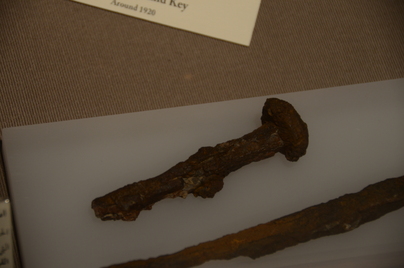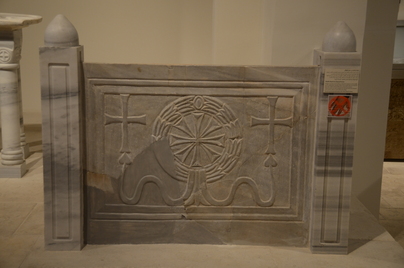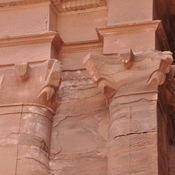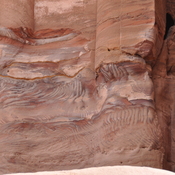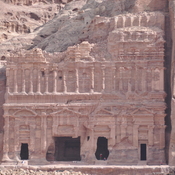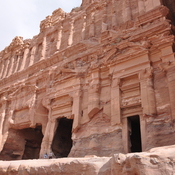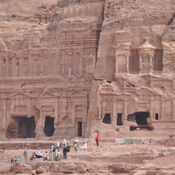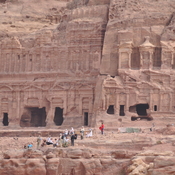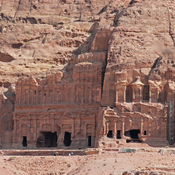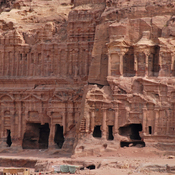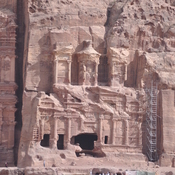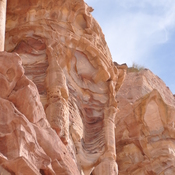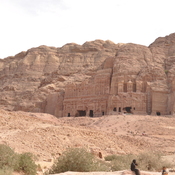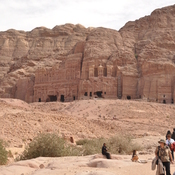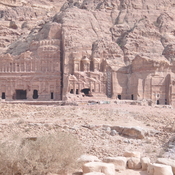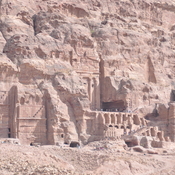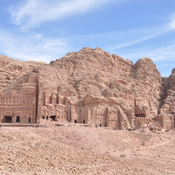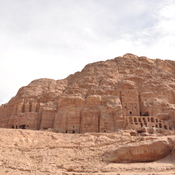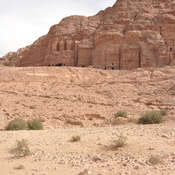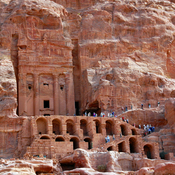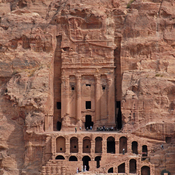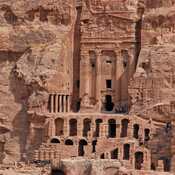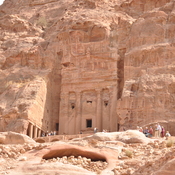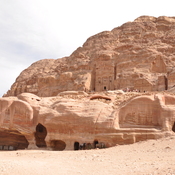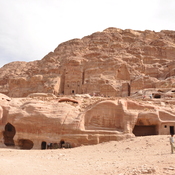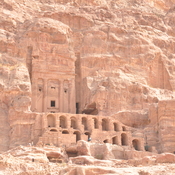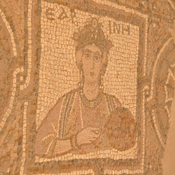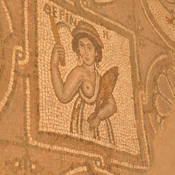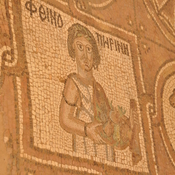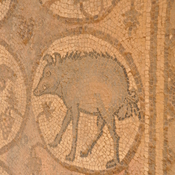Es gibt noch keine deutschsprachige Anmerkungen. Präsentiert wirden Anmerkungen auf English.
Petra is an ancient city in modern Jordan, South of the Dead Sea, today in Jordan. The Nabataeans themselves called Petra Rqm (Rakmu), which means "multi-colored". Petra as the capital of the Nabataeans, attested since 312 BC (Diodorus Siculus (xix. 94–97probably reffers to Petra)1 but they occupied the site probably since the 6th century B.C., when they expelled Edomites from there. From the 3rd century BC the city's role increased significantly because, of its location at the crossroads of trade routes - from India to Egypt and from southern Arabia to Syria. This time Petra became an important communication and trade hub in this region. It reached its peak in the 1st century BC. It was annexed by the Romans under Trajan.
Sources:
- Petra 2023 (n.d), Madain Project, https://madainproject.com/petra, Retrieved on 12 Jan 2024.
- Kanellopoulos, Chrysanthos, and Talal S. Akasheh. “The Petra Map.” Bulletin of the American Schools of Oriental Research, no. 324, 2001, pp. 5–7. www.jstor.org/stable/1357628.
- Pierre M. Bikai and Patricia M. Bikai, Carring for the Cultural Heritage: Shelters in: ACOR Newsletter Vol. 9.1 - Acor Jordan - https://www.acorjordan.org/wp-content/uploads/pdfs/ACOR%20Newsletter%20Vol.%209.1.pdf
- Rudolf-Ernst, Alfred von Domaszewski, Die Provincia Arabia, 1. Die Römerstrasse von Mâdebâ über Petra und Odruh bis el-Aķaba, Strasbourg. 1904, pp. 318 - 319, nos. 412 - 415
- Stephan Schmid, Heinrich Schliemanns, Besuch von Petra im Jahr 1859, in: Reisen in den Orient vom 13. bis zum 19. Jahrhundert , Stendhal, Winckelmann Gesellschaft 2007,pp. 174-183, 278-287 - https://www.academia.edu/11326204
- Laurent Tholbecq, Sanctuaries, taxation and caravans: Wadi Sabra a satellite hamlet of Petra London, Seminar for Arabian Studies, July 24th, 2015 - https://www.academia.edu/14546767
- http://visitpetra.jo/Pages/viewpage.aspx?pageID=142
- http://www.jordan-foto.ru/petra_iordania.htm
- Mahdi Abdelaziz and Shaher Rababeh, The Terminology Used to Describe Tombs inthe Nabataean Inscriptions and itsArchitectural Context, Levant vol. 40, 2008, pp. 195-202
- Piotr Bienkowski, "The Iron Age in Petra and the Issue of Continuity with Nabataean Occupation", in: Stephan G. Schmid and Michel Mouton (Eds.), Men on the Rocks. The Formation of Nabataean Petra, Logos Verlag, 2013, pp. 23–34
- Francisco del Rio Sanchez, Nabatu. The Nabataeans through their inscriptions, Universitat de Barcelona 2015 - chttps://www.academia.edu/17358656
- Naif A. Haddad, Aspects of the Particularity and Creativity of the Nabataean Architectural During the Late Hellenistic and Roman period, Refereed Proceedings of the First International Conference of the Nabataean Culture, Petra: 5 – 8, May 2012, Studies on the Nabatean Culture I , 2013, pp.103-117 - https://www.academia.edu/19772057
- Yvonne Gerber, Positively Byzantine – or more of the same ? Chemical Continuity vs. Discontinuity of the "Byzantine Pottery" in: LRCW3 Late Roman Coarse Wares, Cooking Wares and Amphorae in the ... II BAR International Series 2185 (II) 2010pp. 810-898 - https://www.academia.edu/14192237
Referenzen
- ↑It appears that such are the customs of the Arabs. But when the time draws near for the national gathering at which those who dwell round about are accustomed to meet, some to sell goods and others to purchase things that are needful to them, they travel to this meeting, leaving on a certain rock their possessions and their old men, also their women and their children. 2 This place is exceedingly strong but unwalled, and it is distant two days' journey from the settled country.
Petra is an ancient city in modern Jordan, South of the Dead Sea, today in Jordan. The Nabataeans themselves called Petra Rqm (Rakmu), which means "multi-colored". Petra as the capital of the Nabataeans, attested since 312 BC (Diodorus Siculus (xix. 94–97probably reffers to Petra)1 but they occupied the site probably since the 6th century B.C., when they expelled Edomites from there. From the 3rd century BC the city's role increased significantly because, of its location at the crossroads of trade routes - from India to Egypt and from southern Arabia to Syria. This time Petra became an important communication and trade hub in this region. It reached its peak in the 1st century BC. It was annexed by the Romans under Trajan.
Sources:
- Petra 2023 (n.d), Madain Project, https://madainproject.com/petra, Retrieved on 12 Jan 2024.
- Kanellopoulos, Chrysanthos, and Talal S. Akasheh. “The Petra Map.” Bulletin of the American Schools of Oriental Research, no. 324, 2001, pp. 5–7. www.jstor.org/stable/1357628.
- Pierre M. Bikai and Patricia M. Bikai, Carring for the Cultural Heritage: Shelters in: ACOR Newsletter Vol. 9.1 - Acor Jordan - https://www.acorjordan.org/wp-content/uploads/pdfs/ACOR%20Newsletter%20Vol.%209.1.pdf
- Rudolf-Ernst, Alfred von Domaszewski, Die Provincia Arabia, 1. Die Römerstrasse von Mâdebâ über Petra und Odruh bis el-Aķaba, Strasbourg. 1904, pp. 318 - 319, nos. 412 - 415
- Stephan Schmid, Heinrich Schliemanns, Besuch von Petra im Jahr 1859, in: Reisen in den Orient vom 13. bis zum 19. Jahrhundert , Stendhal, Winckelmann Gesellschaft 2007,pp. 174-183, 278-287 - https://www.academia.edu/11326204
- Laurent Tholbecq, Sanctuaries, taxation and caravans: Wadi Sabra a satellite hamlet of Petra London, Seminar for Arabian Studies, July 24th, 2015 - https://www.academia.edu/14546767
- http://visitpetra.jo/Pages/viewpage.aspx?pageID=142
- http://www.jordan-foto.ru/petra_iordania.htm
- Mahdi Abdelaziz and Shaher Rababeh, The Terminology Used to Describe Tombs inthe Nabataean Inscriptions and itsArchitectural Context, Levant vol. 40, 2008, pp. 195-202
- Piotr Bienkowski, "The Iron Age in Petra and the Issue of Continuity with Nabataean Occupation", in: Stephan G. Schmid and Michel Mouton (Eds.), Men on the Rocks. The Formation of Nabataean Petra, Logos Verlag, 2013, pp. 23–34
- Francisco del Rio Sanchez, Nabatu. The Nabataeans through their inscriptions, Universitat de Barcelona 2015 - chttps://www.academia.edu/17358656
- Naif A. Haddad, Aspects of the Particularity and Creativity of the Nabataean Architectural During the Late Hellenistic and Roman period, Refereed Proceedings of the First International Conference of the Nabataean Culture, Petra: 5 – 8, May 2012, Studies on the Nabatean Culture I , 2013, pp.103-117 - https://www.academia.edu/19772057
- Yvonne Gerber, Positively Byzantine – or more of the same ? Chemical Continuity vs. Discontinuity of the "Byzantine Pottery" in: LRCW3 Late Roman Coarse Wares, Cooking Wares and Amphorae in the ... II BAR International Series 2185 (II) 2010pp. 810-898 - https://www.academia.edu/14192237
Referenzen
- ↑It appears that such are the customs of the Arabs. But when the time draws near for the national gathering at which those who dwell round about are accustomed to meet, some to sell goods and others to purchase things that are needful to them, they travel to this meeting, leaving on a certain rock their possessions and their old men, also their women and their children. 2 This place is exceedingly strong but unwalled, and it is distant two days' journey from the settled country.
























































































